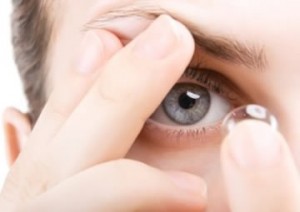 With nearly 40 million Americans and more than 100 million people worldwide wearing contact lenses, contact lens-related eye infections are on the rise. Contact lens-related eye infections can range from mild to severe and are generally the result of handling or replacing contact lenses without proper sanitization.
With nearly 40 million Americans and more than 100 million people worldwide wearing contact lenses, contact lens-related eye infections are on the rise. Contact lens-related eye infections can range from mild to severe and are generally the result of handling or replacing contact lenses without proper sanitization.
Contact Lens-Induced Papillary Conjunctivitis
Contact lens-induced papillary conjunctivitis (CLPC) is one of the most common complications experienced by contact lens wearers. This involves inflammation of conjunctiva, and may result in the need to discontinue contact lens use. Fortunately, symptoms of CLPC subside quickly once changes in vision correction habits or methods are made.
Keratitis
Keratitis, signaling a corneal infection, has multiple causes and treatment methods. For contact lens wearers, the risk of contracting keratitis greatly increases if not caring for contacts regularly. There are several types of keratitis:
- Bacterial Keratitis : Bacterial keratitis, a painful corneal infection, can be caused by trauma to the eye, but is most commonly caused by unsanitary contact lens practices. In addition to pain, symptoms of bacterial keratitis include light sensitivity, decreased vision, and discharge. Ignoring the signs of bacterial keratitis can result in total loss of vision.
- Fungal Keratitis : Fungal keratitis, like bacterial keratitis, can cause blindness if left untreated. Unlike bacterial keratitis, fungal keratitis is caused by a fungal infection. Though it can stem from eye trauma, improper contact lens use and cleaning practices can also lead to this infection. Fungal keratitis has the same symptoms as bacterial keratitis.
- Amoebic Keratitis : Though less common, amoebic keratitis is capable of causing serious harm. Its root cause, Acanthamoeba, can be found in water and nearly everywhere in nature. Symptoms of amoebic keratitis include pain, blurred vision, redness, sensitivity to light, and excessive tearing. Many patients with amoebic keratitis describe a feeling of having “something in the eye,” similar to a sty.
Contact Lens Acute Red Eyes (CLARE)
Though not an actual infection, Contact Lens Acute Red Eyes (CLARE) causes redness, irritation, and eye dryness. CLARE is the result of bacteria colonizing on unclean contact lenses. Because the eye is more fragile with CLARE, contact lens wearers need to be sure to follow their doctor’s eye care recommendations.
Prevent Contact Lens-Related Infections
To prevent eye infections, it’s essential to follow your eye doctor’s recommendations. Contact lenses need to be cleaned regularly and, based on your prescription, replaced at specified intervals. Simply “topping off” old contact lens solution contributes to the formation of bacteria and does not properly sanitize contact lenses. By following your ophthalmologist’s recommendations and maintaining sanitary contact lens habits, you can avoid experiencing the discomfort of an eye infection.
The Takeaway
Wearing contact lenses may seem more appealing than wearing glasses, but without proper care and maintenance, you run the risk of contracting an eye infection. While many eye infections are mild, some can result in vision loss or the need for surgery. Before switching from glasses to contact lenses, make sure you understand how and when to properly clean and replace contact lenses.
